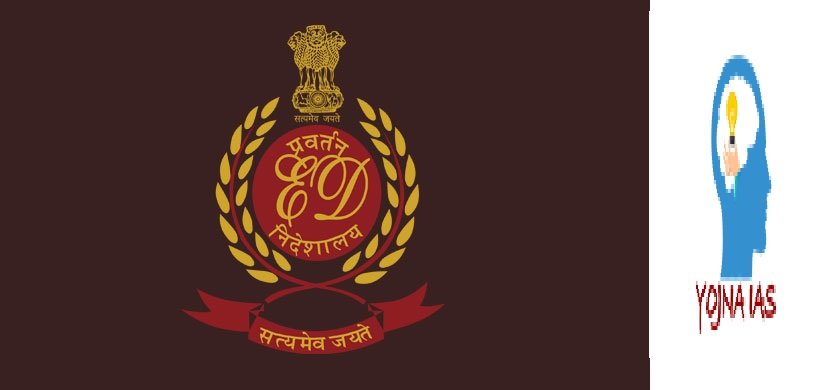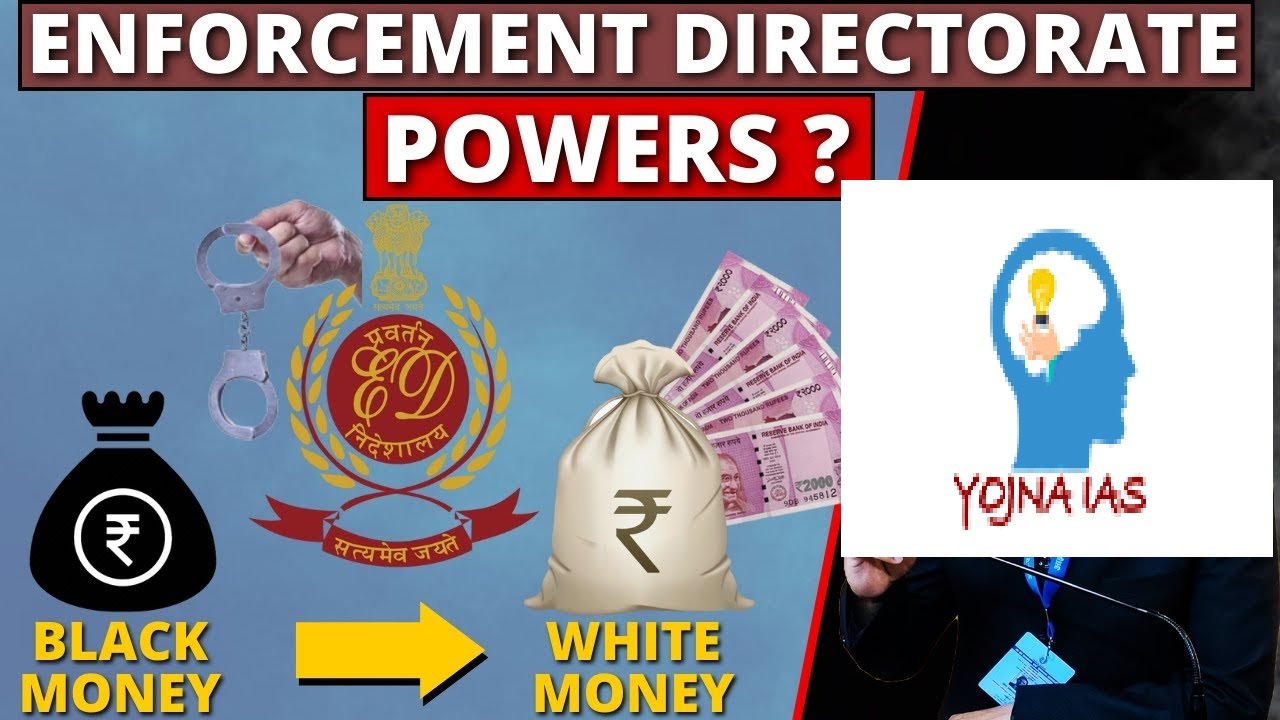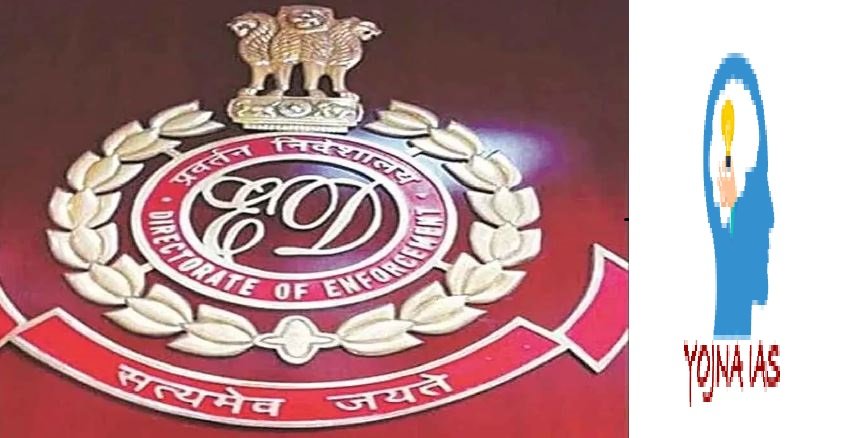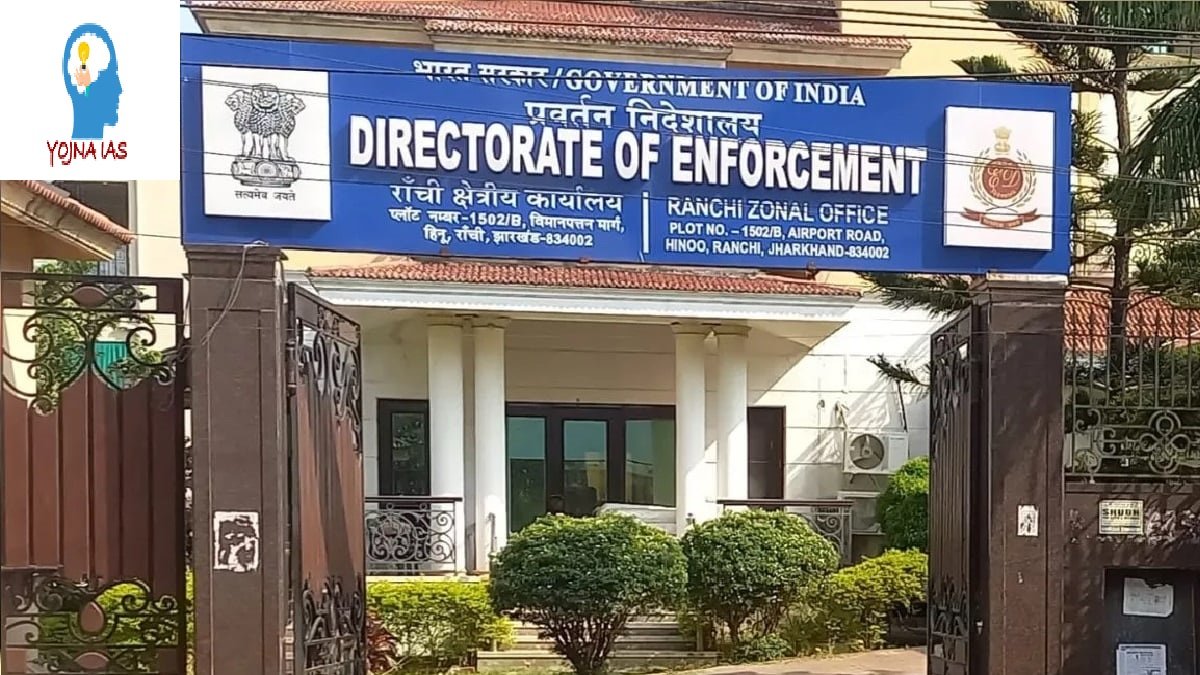02 Mar 2024 Enforcement Directorate and The Federal System of India
Source – The Hindu and PIB.
General Studies – Politics and Governance of India, Federal Form of India, Centre-State Relations, Enforcement Directorate, Money Laundering, Black Money, Money Laundering Act, 2002, Benami Transactions (Prohibition) Amendment Act 2016, Madras High Court, Supreme Court , Centre – State relations.
Why in the News ?

- Recently the Supreme Court of India has given its judgment underlining the duty of Tamil Nadu to the State of Tamil Nadu under the Central laws of India to cooperate in the investigation of the Enforcement Directorate.
- The Supreme Court of India has stayed the order of the Madras High Court according to which the summons earlier issued to the district collectors were postponed.
- According to the decision of the Supreme Court of India, the District Collector is bound to comply with the summons issued by the Enforcement Directorate.
- Recently, the Enforcement Directorate (ED) has summoned the collectors of Tamil Nadu under the Prevention of Money Laundering Act (PMLA) in an attempt to find out whether illegal sand mining in the state of Tamil Nadu is due to corruption or the laundering of ‘money earned’ from it. going.
- The Prevention of Money Laundering Act (PMLA) allows the ED to investigate the money laundering aspect of crimes registered by the police in various states. This does not mean that the ED’s attempt to assess the potential loss to the exchequer on the basis of uncontrolled mining is within its jurisdiction.
- The Supreme Court of India had described the Madras High Court order as a ‘gross misunderstanding of the law’. He has cited Section 50 of the PMLA related to the ED’s power to summon any person to produce any record or give evidence necessary for the investigation.
- The Supreme Court of India noted that the Enforcement Directorate’s investigation was based on first information reports filed in Tamil Nadu and that certain sections of the cases were scheduled offenses under the PMLA.
- The Supreme Court of India has given no importance to the decision of the Madras High Court in the case of Vijay Madanlal Chaudhary vs. Union of India (2022) which was based on the decision of the Supreme Court upholding the PMLA.
- Under Centre-State relations in India, the Tamil Nadu state government and the respective district collectors had filed writ petitions against the ‘usurpation’ of state powers by the central agency and the validity of the summons.
- The Madras High Court, in its 2022 judgment, had said that the ED cannot pursue cases on the presumption or presumption that a crime has been committed.
- Unbridled illegal sand mining, through extraction in excess or without any permission, is quite common in Tamil Nadu.
Enforcement Directorate :
- The Enforcement Directorate was established in 1956 by the central government in India
- It is a special financial investigation agency under the Department of Revenue, Ministry of Finance, Government of India, whose headquarters is located in New Delhi.
- The major functions of the Enforcement Directorate include; Involves investigating cases related to violations of FEMA, 1999, “Hawala” transactions and violations of foreign exchange rules and other types of violations under FEMA.
- Money laundering in India was earlier dealt with under the Foreign Exchange Regulation Act, 1973 but later FERA was replaced by FEMA.
Structure of the office of Enforcement Directorate :

- There are a total 10 regional offices of the Enforcement Directorate in India. Each of these regional offices has a Deputy Director and 11There are sub-regional offices, each sub-regional office headed by an Assistant Director.
Following are the names of the regional offices of Enforcement Directorate in India –
- Mumbai
- Delhi
- 3.Chennai
- Kolkata
- Chandigarh
- Lucknow
- Cochin
- Ahmedabad
- Bangalore
- Hyderabad
Main functions of Enforcement Directorate :
The main functions of the Enforcement Directorate are as follows –
The Enforcement Directorate in India investigates cases related to suspected violations under the provisions of FEMA. The following cases have been included in cases relating to suspected cases of violation of laws in India:–
- Overestimating the export price and underestimating the import price.
- Transactions done under Hawala.
- Buying property abroad outside India.
- Illegal collection of large amounts of foreign currency.
- Illegal trading in foreign currency.
- Matters relating to violation of foreign exchange rules and other types of violations under FEMA.
- The Enforcement Directorate (ED) in India first collects intelligence regarding a case of violation under FEMA’s 1999 laws, and then shares it with case-related agencies in India. The Enforcement Directorate in India receives intelligence and secret information from complaints etc. through the intelligence agencies of the Center and the state concerned.
- The Enforcement Directorate in India has the power to attach or confiscate the property of those found guilty of violating FEMA.
- “Attachment of property” under Chapter III of the Money Laundering Act [Section 2 (1) (D)] means confiscation of property, includes transfer or conversion of property to another person and prohibition of sale of the said property; Is.
- Against those who violate this rule under the Money Laundering Act; It also includes carrying out search, seizure, arrest, and prosecution actions etc.
- To obtain legal extradition from the concerned states for the transfer of money laundering offenders under the Money Laundering Act and. Apart from this, completion of proceedings related to transfer of criminals is also included.
- The Enforcement Directorate (ED) in India is empowered to adjudicate cases of violation of the erstwhile FERA Act 1973 and subsequent FEMA, 1999 in India and decide the penalty imposed at the conclusion of the settlement proceedings.
- Thus, the main objectives of setting up the Enforcement Directorate (ED) include taking legal action against those involved in money laundering in the country, which includes confiscating their assets.

Meaning of Money laundering :
- ‘Money Laundering’ The term originated from mafia groups in the United States. Mafia groups earned huge amounts of money from extortion, gambling, etc. and this money was disguised as legitimate sources (e.g. laundromats). Money laundering became a concern in the United States around the 1980s.
- In India,“Money Laundering” Popularly known as hawala transactions. It was most popular in India during the 1990s when the names of many leaders were exposed in it.
- Money laundering refers to disguising black money earned illegally as legitimate money. Money laundering is a way of hiding money obtained illegally.
- The money obtained through money laundering is invested in such works or in such investments that even the investigating agencies are not able to trace the main source of the money.
- A person who misappropriates money in the process of laundering money obtained illegally is ” launderer ” It is said.
- In the process of money laundering, black money earned through illegal means turns white and returns to its rightful owner in the form of legal tender.
The process of Money laundering involves the following three steps –
-
Placement
-
Layering
-
Integration
Placement :
- First in the process of money laundering This phase involves the entry of cash into the market. In this, the launderer deposits the illegally earned money in cash in financial institutions such as banks or other types of formal or informal financial institutions.
Layering :
- money laundering process The second step in ‘layering’ is related to hiding money. In this, the launderer hides his real income by making irregularities in the accounting books and doing other suspicious transactions. The launderer places the funds in investment instruments such as bonds, stocks, and traveler’s checks or deposits them in bank accounts abroad. These accounts are often opened in banks of countries that do not cooperate with India’s anti-money laundering operations.
Integration :
- money laundering process final stage of integration. Through this process, money sent outside India or spent within the country comes back to the launderer in the form of legitimate money. Such money often comes back to its original owner through investing in a company or buying real estate or buying luxury goods, etc.
Activities included in money laundering :

- There can be many ways to do it, the most important of which is – “Creating a fake company” whom “Shell Companies” Is also called.
- Shell companies are a company like a real company but do not actually hold any assets nor do any actual production activities take place in them.
- These shell companies exist only on paper, they do not exist in reality, but the launderer shows huge transactions in the balance sheets of these companies.
- The launderer takes loans in the name of these companies and also takes tax exemption from the government, but does not file income tax returns and through all these fraudulent activities, he accumulates a lot of black money.
- If a third party wishes to examine his financial records, false documents are produced to the third party to confuse the investigation as to the source and location of the funds.
- Other methods of money laundering include buying a big house, shop or mall but underreporting its value on paper while the actual market value of the purchased property is much higher. This is done so that it can reduce the burden on the government Tax ‘ Have to give. Thus ‘tax evasion ‘ Black money is also raised through.
- Another method of money laundering is when Launderer through many means, people deposit their money in the banks of such countries where the Government of India or the government of any other country does not have the right to check their account. The biggest example of this is Switzerland where a large number of Indians have black money accumulated which has been earned through money laundering.
Money Laundering Act, 2002 to prevent money laundering in India :
- The Money Laundering Act in India was enacted in 2002, but has been amended 3 times (2005, 2009 and 2012). The last amendment made in it in the year 2012 got the assent of the President on January 3, 2013 and this law came into force across India from February 15, 2013. The PMLA (Amendment) Act, 2012 has included concealment, acquisition and possession of money and use of proceeds of crime in the list of offenses.
- PMLA, RBI, SEBI and Insurance Regulatory and Development Authority (IRDA) were brought under PMLA in 2002 and hence all the provisions under this Act apply to all financial institutions, banks, mutual funds, insurance companies and their financial intermediaries. Are.
Benami Transactions (Prohibition) Amendment Act 2016 :
- This Act amended the parent Act, the Benami Transactions (Prohibition) Act 1988 and renamed it as the Benami Property Transactions (Prohibition) Act, 1988. The Act defined a benami transaction as a transaction where: Is held by or transferred to one person but is provided or paid for by another person. Transactions done in a fake name may result in transfer of ownership of the property to the owner If no information is available about the property, the person submitting the claim for the property is not verifiable.
Appellate Tribunal :
- The Act provides for an Appellate Tribunal to hear appeals against any order passed by the adjudicating authority.
- An appeal can also be made to the High Court against the orders of the Appellate Tribunal.
- The Special Court will have to complete the trial within six months from the date of filing of the complaint.
Conclusion / Way forward :

- The process of money laundering is very complex and cunning, to stop it, the Government of India should develop financial infrastructure in India to allow payments through electronic means as much as possible.
- The laws against money laundering in India are currently such that it appears to us as a possible violation of the federal nature of India and federal principles. The laws against money laundering in India need to be made more stringent, transparent and equitable so as to put a stop to the accumulation of black money in India.
- Whatever may have been the reason behind the summoning of Tamil Nadu collectors by the Enforcement Directorate officials, it raises questions on the independent existence and impartiality of the officials of the Enforcement Directorate of India. Therefore, it is necessary that the Enforcement Directorate of India should perform its work independently and impartially, without any pressure or ill intentions.
- Various states in India have been accused of misusing central investigative agencies, intimidating opposition political parties or being biased against states ruled by their political opponents by the government in power at the Centre. In such a situation, the Central Investigative Agencies also need to remain impartial, independent and neutral and need to implement the powers given to them under their jurisdiction by the Constitution of India without any bias and impartially so that in future there will be no Central-State conflict in India. There should not be a situation of deadlock in relationships.
Practice Questions for Preliminary Exam :
Q.1. Consider the following statements regarding the Enforcement Directorate.
- In India, the Enforcement Directorate was established by the Central Government in 1996.
- It is a special financial investigation agency under the Revenue Department of the Ministry of Finance, Government of India, whose headquarters is located in Kolkata.
- There are a total of 29 regional offices of the Enforcement Directorate in India.
- The Enforcement Directorate in India has the power to attach or confiscate the property of those found guilty of violating FEMA.
Which of the above statement /statements is/ are correct?
(A) Only 1 and 3
(B) Only 2
(C) Only 3 and 4
(D) Only 4
Answer – (D)
Practice Questions for Main Exam :
Q.1. Outlining the structure and main functions of the Enforcement Directorate of India, discuss whether misuse of any central investigative agency under Centre-State relations in India is compatible with the democratic nature of India? give a logical explanation.
Qualified Preliminary and Main Examination ( Written ) and Shortlisted for Personality Test (INTERVIEW) three times Of UPSC CIVIL SERVICES EXAMINATION in the year of 2017, 2018 and 2020. Shortlisted for Personality Test (INTERVIEW) of 64th and 67th BPSC CIVIL SERVICES EXAMINATION.
M. A M. Phil and Ph. D From (SLL & CS) JAWAHARLAL NEHRU UNIVERSITY, NEW DELHI.


No Comments